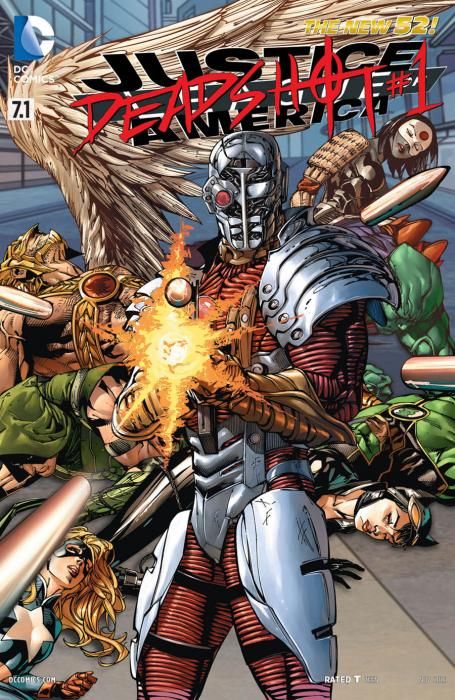"Justice League of America #7.1: Deadshot" is really two comics mashed together. While both are written by Matt Kindt and star Deadshot, that's the only real connection. Half of the book set in the past tells Deadshot's origin (with Carmeno Carnero's pencils) while the other half in the present has Sami Basri pencil what Deadshot's up to in "Forever Evil." Much to my surprise, the half that I thought would be less interesting was the one that grabbed my attention much more.
"Justice League of America" #7.1's flashback into Deadshot's past seemed like it would be holding attention much more than it did. When the scene opens, it shows a family down on their luck that looks to finally have things start to turn around. Then disaster strikes, and everything comes crashing down and in the process young Floyd becomes the sharpshooting assassin known as Deadshot. It never quite clicks, though. Young Deadshot never quite comes across as an interesting character, and his transformation from innocent kid to stonehearted incredibly-accurate killer feels like it's near instantaneous. (I'm also not entirely sure what to make of the idea that Deadshot's bullets have computer chips in them to make them more accurate; it feels like it's taking away from the skill that the character is supposed to possess.)
The one slightly interesting part of this half of the comic is how Carnero draws the scene where stray bullets wipe out Deadshot's family. I like how the dividing walls between apartments are used as panel borders, it's a clever choice. I do wish that Carnero and Kindt took this even farther, though, and perhaps had created this sequence as a two-page spread with a series of rows where all of them showed the entire scene; bedroom, kitchen, next-door's living room, and then hallway. Once you see the comic for yourself, you'll instantly see what I'm talking about, and how that could have been portrayed in a manner that is almost entirely unique to comics.
It's the present-day sequence that in the end pulls "Justice League of America" #7.1 together. Deadshot's "I'll do anything for money" attitude is fine, but it's the way he dispatches an associate of his target that ultimately clicks everything into place. This is an extremely dangerous man, and he's someone that you should fear. Not just because he's an amazing marksman, but because of the way he views his targets and the best way for him to achieve his goals. Kindt turns this part of the comic into a nasty look into Deadshot's soul, and it's not a pretty place.
It doesn't hurt that Basri's pencils are great. Why Basri wasn't snatched up for a new regular assignment after the end of "Voodoo" is a mystery, because I love Basri's smooth lines and tight viewpoints in his panels. Even with a lot of speed lines during Deadshot's plummet towards the ground, it feels like every panel is carefully crafted and thought through, and the expressions on the faces of Amanda Waller as well as his target's associate both sell Kindt's script. Even something as simple as the two panels that strip away the armor so we can see the inside of the target looks great; it's clean, your eyes track easily from one image to the next, and I love the little touches like how we see some of the mechanics of the armor even as the outside is faded away.
"Justice League of America" #7.1 works well as a preview for Kindt's taking over of "Suicide Squad" next month; not only does this lead directly into "Suicide Squad" #24, but it also gives me hope that the book will be in good hands. And for that alone, I'd say mission accomplished.

